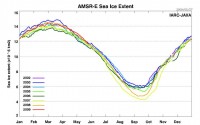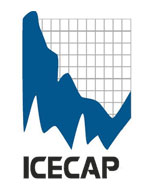By Dr. Anthony Lupo
For those who are proponents of the idea that humankind is harmfully warming the climate by adding greenhouse gasses to the earth’s atmosphere, it is also an article of faith that we can engineer our own solutions through policy prescriptions or burdensome regulations. So it is with Energy Secretary Dr. Steven Chu who claimed that we can offset a large part of the expected human-induced warming by changing roofs to white and urban surfaces to a lighter, more reflective color.

In tropical and subtropical island climes, they often use white roofs to help keep houses cooler where there are no trees to shade. The roofs are often terraced in a way to capture fresh water, often in short supply on islands. In middle to high latitudes, roofs are often white part of the year. It is called snow.
There are many real climate scientists out there who question such silly statements and are not afraid to point out that trying to modify urban areas on such a grand scale would be a very expensive endeavor while delivering a small payoff. Dr. Roy Spencer[1] convincingly demonstrates that such a prescription would offset only a very small portion of the expected CO2 emissions, and thus probably not make much of a difference in global temperatures. Dr. Lubos Motl[2] also performs some back-of-the-envelope calculations to demonstrate that the impact of Steven Chu’s prescription might result in a global temperature change on the order of 0.01C or less.
My own critique of Dr. Chu’s statement has come a bit slower as I am generally a step or two behind many of the skeptics like those cited above. One also might ask the question; what would be the real impact of brightening urban surfaces on the current climate and even the weather. After reading Chu’s statement, I was reminded of an experiment that I’d done with a simple climate model some 15 - 20 years ago in a graduate class back at my alma mater. After doing some digging, I found this report and the data, and then reviewed what was done.
In this experiment, a statistical-dynamic climate model (SDM) was used (Oglesby et al. (1990)). A statistical-dynamic model is much simpler than the general circulation models (GCMs) used today (see [4] for a discussion of GCMs on this website). The SDM uses the same mathematical core that a GCM uses, but only yields two-dimensional solutions of climate that are steady-state (can be used to diagnostically). The GCM by contrast can yield fully three-dimensional solutions that can vary with time (or be used as a forecast model). Additionally, the SDM has simpler versions of all the critical physics of a GCM, so the advantage is that the computer program is only about 1% as long as a GCM. It can give nearly instantaneous results compared to the GCM. These advantages were big at the time when computer space was at a premium.
In one experiment, the SDM model was used in which the earth’s surface albedo, or the amount of reflected radiation, was decreased for all the land on earth by about 2.5%. Keep in mind about 30% of the earth’s surface is land-covered. The global temperature was increased by about 0.04 C. These numbers are consistent with the numbers quoted on the two blogs cited above. In fact, using the numbers presented in [1], [2] is the equivalent of reducing the albedo over the entire land surface of the planet by less than 1%. This is less than half the amount of reduction done in the SDM experiment described above. See the full pdf here.
By Megan Rowling, London, May 29 (Reuters)
Climate change kills about 315,000 people a year through hunger, sickness and weather disasters, and the annual death toll is expected to rise to half a million by 2030, a report said on Friday. The study, commissioned by the Geneva-based Global Humanitarian Forum (GHF), estimates that climate change seriously affects 325 million people every year, a number that will more than double in 20 years to 10 percent of the world’s population (now about 6.7 billion).
Economic losses due to global warming amount to over $125 billion annually—more than the flow of aid from rich to poor nations—and are expected to rise to $340 billion each year by 2030, according to the report. “Climate change is the greatest emerging humanitarian challenge of our time, causing suffering to hundreds of millions of people worldwide,” Kofi Annan, former U.N. secretary-general and GHF president, said in a statement.
“The first hit and worst affected are the world’s poorest groups, and yet they have done least to cause the problem.” The report says developing countries bear more than nine-tenths of the human and economic burden of climate change, while the 50 poorest countries contribute less than 1 percent of the carbon emissions that are heating up the planet.
Annan urged governments due to meet at U.N. talks in Copenhagen in December to agree on an effective, fair and binding global pact to succeed the Kyoto Protocol, the world’s main mechanism for tackling global warming. “Copenhagen needs to be the most ambitious international agreement ever negotiated,” he wrote in an introduction to the report. “The alternative is mass starvation, mass migration and mass sickness.”
The study warns that the true human impact of global warming is likely to be far more severe than it predicts, because it uses conservative U.N. scenarios. New scientific evidence points to greater and more rapid climate change. The report calls for a particular focus on the 500 million people it identifies as extremely vulnerable because they live in poor countries most prone to droughts, floods, storms, sea-level rise and creeping deserts. Africa is the region most at risk from climate change, home to 15 of the 20 most vulnerable countries, the report says. Other areas also facing the highest level of threat include South Asia and small island developing states.
To avoid the worst outcomes, the report says efforts to adapt to the effects of climate change must be scaled up 100 times in developing countries. International funds pledged for this purpose amount to only $400 million, compared with an average estimated cost of $32 billion annually, it notes. “Funding from rich countries to help the poor and vulnerable adapt to climate change is not even 1 percent of what is needed,” said Barbara Stocking, chief executive of Oxfam in Britain and a GHF board member. “This glaring injustice must be addressed at Copenhagen in December.”
Read this UN warning to the developed world here.
A similar load of nonsense was offered by the UK TimesOnLine as environmentalist groups and a sympathetic media lobby for major global changes ahead of Copenhagen here.
Icecap Note: If the UN and envionmentalists really cared about the poorer nations, they would encourage the building of power plants to bring electricity, clean energy for cooking, clean water and sanitation and proper medical care instead of keeping them living a primitive existence while at the same time, crippling the world’s producing countries by limiting the enegy they utilize and restricting harmless carbon dioxide emissions that only serve to increase crop yields. They neglect the fact that global temperatures are cooling, ocean heat content is dropping, polar ice recovering, and sea level rises slowing, all falsifying the climate models they use to create the big scare. The following graphic (enlarged here) from Ian Plimer’s landmark book Heaven and Earth: Global Warming - The Missing Science, flying off the shelves that this is blatantly wrong.

By Anthony Watts, Watts Up With That
During the the last week, NSIDC graphs of arctic sea ice extent have been dropping so steeply that many have called them into question. Finally NSIDC
ended the daily updates and have left the last “good” image of May 21st in place in the web folder, but have placed an “out of order” sign on the website.
As we first pointed out to NSIDC back on 2/18/09 (even though it “wasn’t worth blogging about") the sensor has been on the fritz for quite awhile, calling the whole arctic sea ice series into question. From their most recent announcement, it looks like that it is now “DOA”.
Here’s what they say now. From NSIDC’s web site: Update: May 26 2009 The daily image update has been temporarily suspended because of large areas of missing data in the past week. NSIDC currently gets its data from the SSM/I sensor on the DMSP F13 satellite, which is nearing the end of its operational life and experiencing intermittent problems.
NSIDC has been working on a transition to a newer sensor on the F17 satellite for several months. At this time, we have more than a year of data from F17, which we are using to intercalibrate with F13 data. The F17 data are not yet available for near-real-time updates. We will resume posting daily updates as soon as possible, either from F13, if the present problem is resolved, or from F17, when the transition is complete.
It doesn’t look promising to get any usable data for the last 6 months or more, since it clearly has been corrupted by the sensor issues. Meanwhile the AMSR-E on the Aqua satellite chugs right along on JAXA (below with larger image here).

From NANSEN, here is a map showing differences between AMSR and SSMI. There are some huge chunks missing. (h/t to Fred Nieuwenhuis for the link)
Personally I think it was folly for NSIDC to try to use different channels on the DMSP F13 satellite to nurse the dataset along, as we’ve seen it is not just the single channel on SSM/I sensor that has had problems.
Transitioning to the DMSP F17 satellite “may” be a plan, but the AQUA satellite and the AMSR-E package seems to be quite reliable and with a number of years of life ahead. It is also used by many other agencies to reliably gauge sea-ice.
IMHO, NSIDC is doing themselves no favors by sticking with the DMSP SSM/I satellite platform package. The science world has moved on with AQUA’s AMSR-E, and it is time for NSIDC to move on as well.
Otherwise, they are going to be “has beens” using older technology. Get with the program guys. You need good supporting data so incoming director Mark Serreze can give us his fabulous forecasts and media soundbites that don’t seem to come true.
See full story and comments here.


